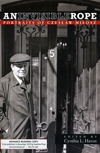An Invisible Rope
Cynthia L. Haven has gathered an exquisite collection of thirty-two memoirs, which pay tribute personally through historical and personal accounts of one of the most celebrated poets, Czeslaw Milosz. The bevy of contributors who share encounters with Milosz spin intimate stories oft with intimate ease—spanning from the 1930s until just days before his death in 2004. Haven did an excellent job selecting memoirs from a well-credentialed, diverse group of contributors who represent political, literary, environmental, cultural and spiritual spectrums on many levels. She also weaves in lines form Milosz’s vast works in relation to the time period, stories, and references.
Cynthia L. Haven has gathered an exquisite collection of thirty-two memoirs, which pay tribute personally through historical and personal accounts of one of the most celebrated poets, Czeslaw Milosz. The bevy of contributors who share encounters with Milosz spin intimate stories oft with intimate ease—spanning from the 1930s until just days before his death in 2004. Haven did an excellent job selecting memoirs from a well-credentialed, diverse group of contributors who represent political, literary, environmental, cultural and spiritual spectrums on many levels. She also weaves in lines form Milosz’s vast works in relation to the time period, stories, and references.
One of the most touching, soul revealing glimpses in the book describes a conversation with Milosz and Dr. Bogdana Carpenter. They were commenting on details of the sculpture of his late and beloved wife Carol Thigpen. Milosz stated, “Now I have her only in stone.” Carpenter goes on to connect his statement to her recollection of Milosz’s poem, “Orpheus and Eurydice”:
I thought of the beautiful and moving poem “Orpheus and Eurydice” Milosz wrote after Carol’s death: “Only her love had warmed him, humanized him.” And then his desperate cry: “Eurydice! How will I live without you, my consoling one!”
For many, Milosz’s work continues to be an invisible rope—like a life line and inspiration rescue for fellow writers who also write from deep-rooted experience that can help make a difference/change. Much thanks to translators, Milosz’s poetry and prose continues to timelessly inspire readers and writers.
Just a few years ago, I was unexpectedly introduced to Milosz’s influence during a casual read of A Monk’s Alphabet, by poet and Benedictine theologian, Fr. Jeremy Driscoll. Driscoll’s sprinkled mentions of Milosz whet my own literary and intellectual appetite to learn more about Milosz’s immense body of work. Haven’s collection is a very insightful read for both old and new fans of Milosz. In fact, I highly recommend it to fellow poets or scholars who are “new” to him because it can deepen the appreciation for his work prior to reading more of it. This book is the ultimate “back story.”





